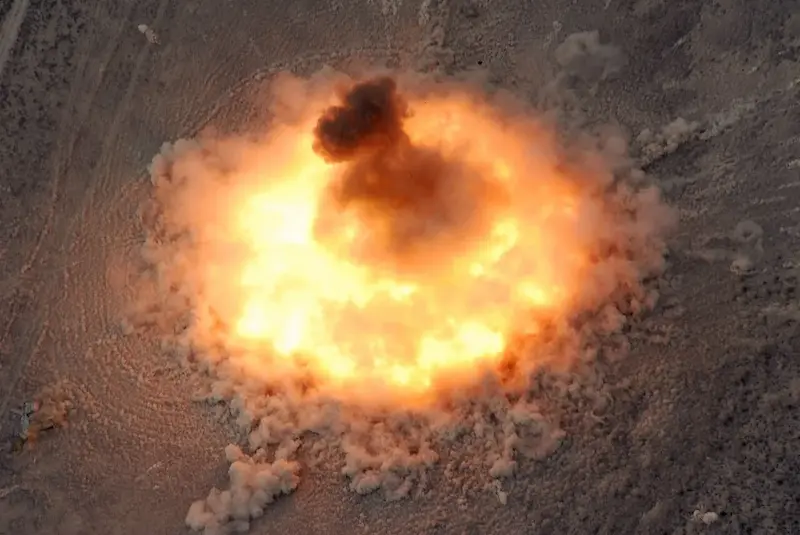
China’s successful test of a non-nuclear hydrogen bomb has stunned defense analysts worldwide
I. The Hydrogen Bomb Test That Shook the Battlefield
In April 2025, China’s 705 Research Institute, under the China State Shipbuilding Corporation, successfully tested a non-nuclear hydrogen bomb that stunned global defense analysts. The compact 2-kilogram device, powered by magnesium hydride, produced a white-hot fireball exceeding 1,000°C, sustaining combustion for over two seconds 15 times longer than TNT.
Unlike traditional nuclear weapons, this hydrogen bomb:
- Does not emit radioactive fallout
- Relies on a chemical chain reaction, not nuclear fission or fusion
- Is designed for precision thermal strikes, especially in urban warfare scenarios
The explosion was powerful enough to melt aluminium alloys, with heat dispersing uniformly across wide areas. According to lead researcher Wang Xuefeng, the bomb’s ignition requires minimal energy and spreads rapidly, making it ideal for targeted destruction.
This test signals China’s push toward clean-energy weaponry, aligning with its broader defense modernization strategy. The weapon’s psychological impact mimicking nuclear devastation without triggering global catastrophe could redefine how deterrence is imagined.
II. Strategic Disruption: Deterrence Without Annihilation
Historically, deterrence has hinged on the threat of mutually assured destruction. Nuclear weapons were feared not for their use, but for the existential risk they posed. China’s hydrogen bomb challenges this paradigm by offering:
- High-impact devastation without mass civilian casualties
- Operational plausibility without triggering nuclear treaties
- Psychological intimidation through sustained thermal damage
Defense theorists argue this could usher in a new era of deterrence—one based on precision, plausibility, and survivability. Imagine a strike that disables military communications, blinds satellites, and paralyzes air defenses without destroying cities or triggering nuclear winter.
While China’s hydrogen bomb is still tethered to blast radius logic, its non-radioactive nature makes it deployable without global fallout. This could erode the monopoly nuclear weapons have held over strategic fear and shift power dynamics in regions like the South China Sea and Taiwan Strait.
India, the U.S., and other powers are now reassessing their own deterrence models. The weapon’s development has sparked calls for:
- Advanced heat-resistant materials
- EMP-hardened infrastructure
- Countermeasures against thermal and chemical chain reactions
III. Global Response and Tactical Implications
The test’s timing amid rising tensions with Taiwan and increased U.S. support for Indo-Pacific allies suggests strategic signalling. Analysts believe the weapon could be used in:
- Urban warfare, where minimizing collateral damage is key
- Anti-Armor and anti-electronics operations
- Area-denial missions in contested zones
However, challenges remain:
- Magnesium hydride production is limited, with only a few grams synthesized daily due to its volatility
- Operational deployment is risky, as the material reacts fatally to air exposure
- Integration into PLA arsenals will require breakthroughs in safety and scalability
Despite these hurdles, China’s test has:
- Redefined non-nuclear warfare
- Raised alarms across defense ministries
- Prompted calls for international regulation of high-energy chemical weapons
India’s defense experts have urged DRDO and RAW to monitor China’s magnesium hydride supply chains and accelerate development of counter-drone and hypersonic missile systems. The U.S. and Quad partners are exploring AI-driven deterrence models and directed-energy weapons to match China’s innovation curve.
Feature Comparison: China’s Hydrogen Bomb vs Traditional Explosives
| Feature | China’s Hydrogen Bomb | TNT Explosive | Nuclear Bomb |
| Type | Non-nuclear chemical | Conventional | Nuclear |
| Fireball Duration | ~2 seconds | ~0.13 seconds | ~10 seconds |
| Temperature | >1,000°C | ~300°C | >10 million°C |
| Fallout | None | None | Radioactive |
| Deployment Risk | High (chemical hazard) | Low | Extreme |
| Strategic Deterrence Value | High | Low | Very High |
Stay updated with the latest news on Rapido Updates. Keep yourself updated with The World, India News, Entertainment, Market, Automobile, Gadgets, Sports, and many more